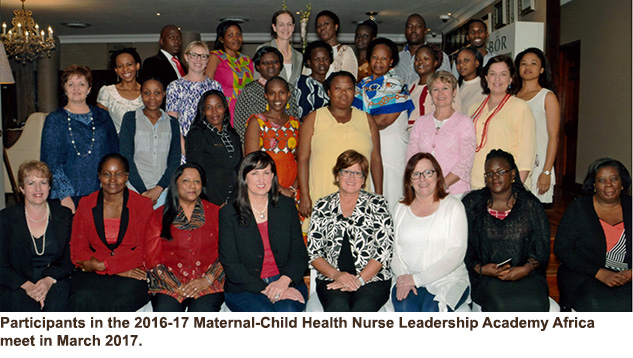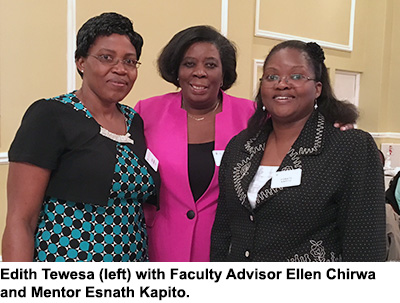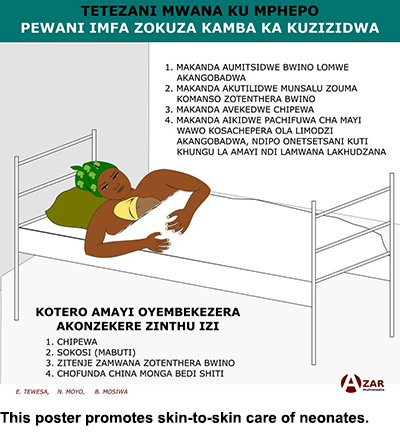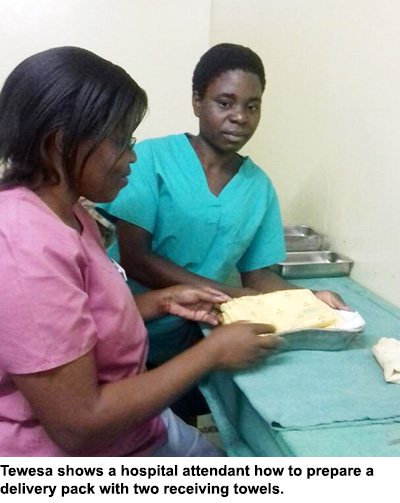MCHNLA Africa project cuts hypothermia admissions by 40 percent in one year. 
A leadership project initiated by a nurse in Malawi has significantly decreased the incidence of hypothermia in neonates. Edith Tewesa, senior nursing officer at Ministry of Health Malawi, developed the project as one of 12 Mentees in the 2016-17 Maternal-Child Health Nurse Leadership Academy Africa (MCHNLA Africa). The academy is presented by the Honor Society of Nursing, Sigma Theta Tau International (STTI) in partnership with Johnson & Johnson.
 Ellen Chirwa, acting principal at University of Malawi, Kamuzu College of Nursing, is Tewesa’s Faculty Advisor. Chirwa speaks to the importance of the academy: "The leadership academy empowers nurse midwives with essential knowledge, skills, and behaviors for implementing quality improvement projects that contribute to saving lives of mothers and children.”
Ellen Chirwa, acting principal at University of Malawi, Kamuzu College of Nursing, is Tewesa’s Faculty Advisor. Chirwa speaks to the importance of the academy: "The leadership academy empowers nurse midwives with essential knowledge, skills, and behaviors for implementing quality improvement projects that contribute to saving lives of mothers and children.”
For her MCHNLA Africa leadership project, Tewesa worked with Chirwa and Mentor Esnath Kapito, lecturer at University of Malawi, Kamuzu College of Nursing, to design, implement, and manage a team leadership project that focuses on reducing neonatal hypothermia, a contributing cause of morbidity and mortality in developing countries.
Tewesa’s project specifically focuses on neonates at Queen Elizabeth Central Hospital (QECH) in Blantyre, Malawi. Between January and February 2016, she observed that nearly half (47 percent) of neonates admitted to the neonatal unit had hypothermia. Due to inadequate drying, some were still wet when admitted to the unit. This, in addition to inappropriate warming practices, greatly contributed to hypothermia.
 Tewesa discovered that, because receiving towels were not included in the delivery packs, the mother’s nylon sheets were often used, ineffectively, to dry babies after delivery. In addition, there were no hats for the babies, linens to keep mother and baby warm for skin-to-skin contact, or educational materials on the risks of and ways to prevent hypothermia.
Tewesa discovered that, because receiving towels were not included in the delivery packs, the mother’s nylon sheets were often used, ineffectively, to dry babies after delivery. In addition, there were no hats for the babies, linens to keep mother and baby warm for skin-to-skin contact, or educational materials on the risks of and ways to prevent hypothermia.
To address these important needs, Tewesa secured resources from several sources:
- Two receiving towels for each delivery pack (contributed by QECH)
- Hats for the labor ward (from well-wishers who learned about the project)
- Bedsheets for skin-to-skin care with stable babies for at least one hour after birth (from QECH)
- Educational posters in Chichewa—Malawi’s national language—posted in all labor ward cubicles, the antenatal ward, and clinics to remind healthcare providers and empower mothers to protect babies from hypothermia (from the Paediatrics and Child Health Association and Fattan Offset Printers).
As part of her MCHNLA Africa leadership project, Tewesa led interprofessional sessions on prevention of hypothermia for 21 midwives and five mentor mothers who assist in education sessions at the antenatal clinic and antenatal ward. She also trained an additional 28 hospital and patient attendants who assist in taking care of receiving towels and linens.
Already, Tewesa and QECH are seeing positive results from this project:
- The number of neonates admitted to the neonatal unit with hypothermia decreased from 47 percent in February 2016 to 18.9 percent in February 2017, or 40 percent fewer in one year.
- Only 5.9 percent of neonates born at QECH between December 2016 and February 2017 were admitted to the neonatal unit with temperatures between 32 and 34.9 degrees Celsius, compared to 30 percent of those referred from other facilities.

Tewesa’s goals for this project extend past her completion of MCHNLA Africa. At QECH, she aims to reduce cases of hypothermia admitted to the neonatal unit from all areas by 98 percent by continuing to monitor temperatures of all babies and improving the environment of the labor ward to ensure thermoregulation in winter. She also plans to implement these changes in health facilities that refer neonates to QECH. Upon completion of her project in August 2017, the practice changes Tewesa has designed, implemented, and managed are expected to reach 49 healthcare providers and 1,400 mothers and babies they serve.
About MCHNLA Africa
In addition to support from STTI and Johnson & Johnson, MCHNLA Africa receives funds from donations to the STTI Foundation’s Future (21st Century) Fund. The 18-month academy prepares nurses and midwives for effective interprofessional team leadership as they strive to improve healthcare quality for underserved childbearing women and children up to 5 years old. The current academy—composed of 12 triads from Malawi, South Africa, Swaziland, and Uganda—is projected to reach more than 800 healthcare providers and 13,000 mothers and children after the academy concludes. Mentees will give poster presentations of their projects at the Chi Xi-at-Large Chapter Research Conference in Swaziland in August 2017.
Rebecca Frey is development officer for the Sigma Theta Tau International Foundation for Nursing.